#Historic Mount Rainier
Explore tagged Tumblr posts
Text
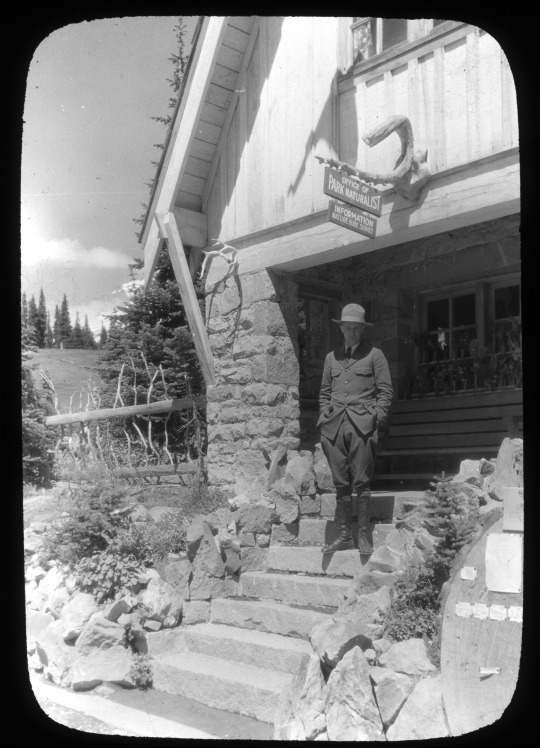
Mount Rainier National Park Archives Photo of the Paradise Ranger Station with the park’s first naturalist, Ranger Floyd Schmoe, in the 1920s.
The Paradise Ranger Station was constructed in 1921 and was the first government-built structure of its kind at Mount Rainier. Built by the National Park Service in the Rustic style, its steeply pitched roof was designed to withstand the excessive amounts of snowfall at Paradise. The front has a full width 1-story stone porch accessed by stone steps, which descend directly onto the sidewalk. The NPS Rustic style uses native materials like wood and stone to minimize contrast from the natural setting. Shrubs and trees were also planted around the ranger station to better help it blend with the environment and not detract from the visitors’ experience of nature. The Paradise Ranger Station is part of the Mount Rainier Historic Landmark District.

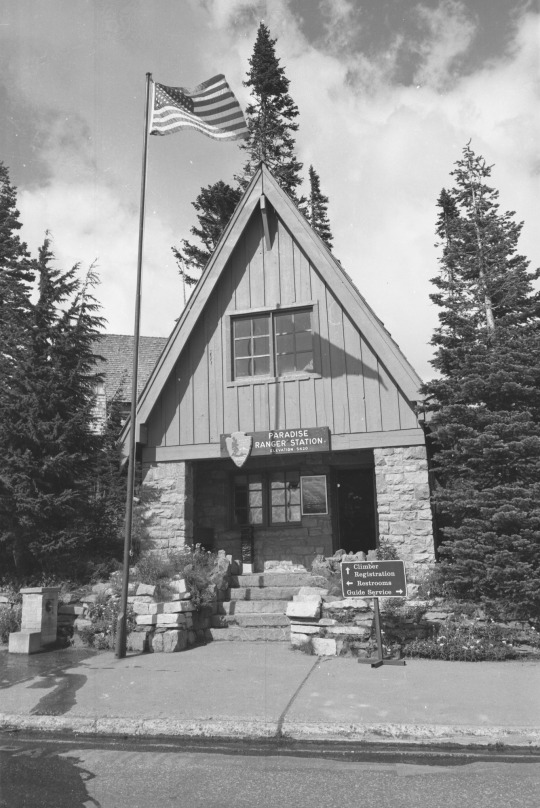
NPS Photo of the ranger station in 1984 (left). Mount Rainier National Park Archives Photo courtesy Val Lou photo of the Paradise Ranger Station in the 1990s (right).
The first floor of the ranger station was originally used as an information and checking station, with living quarters in the second story. The information center has since moved to the Climbing Guide House behind the ranger station, but the Paradise Ranger Station still serves as office space for rangers today. Have you noticed this building when visiting Paradise?
#Historic Mount Rainier#mount rainier national park#Paradise Ranger Station#Paradise#National Historic Landmark District#historic building#ranger station#NPS Rustic#architecture
87 notes
·
View notes
Text
wikipedia tabs i have open on new year's day
Railgun
Gunboat
Loess
Kamchatka Peninsula
Ansible
Hainish Cycle
Key deer
Mount Rainier
Socialism with Chinese characteristics
Xi Jinping Thought
Historical nihilism
Three Represents
Scientific Outlook on Development
Blue crab
Callinectes sapidus
Crab cake
Diamondback terrapin
Turtle soup
Yellow-bellied slider
Red-eyed slider
Littoraria irrorata
Halite
Appanage
Princess
Penicillin
Raffinate
Kaali crater
Hittite mythology and religion
Augury
Dovecote
Fasenjān
Confucianism
Messier 87
Elliptical galaxy
Whirpool Galaxy
Spiral galaxy
Pinwheel Galaxy
Milky Way
Sagittarius A*
Messier 87
History of Christian universalism
Kardashev scale
Grand duke
PSR B1257+12
PSR B1257+12 B
55 Cancri e
Carbon planet
Chthonian planet
Tholin
Luna (goddess)
European rabbit
Heroin
Abscess
Acedia
Weltschmerz
Razor
Synthetic fiber
Marshal of Yugoslavia
65 notes
·
View notes
Text




Blue hour, PARADISE INN at MT. RAINIER National Park, Washington, USA 🇺🇸
Paradise Inn is a historic hotel built in 1916 at 1,600 m (5,400-foot) on the south slope of Mount Rainier in Mount Rainier National Park, Washington, Unites States.
5 notes
·
View notes
Text
5 Hidden Gem National Parks to Explore in the USA
5 hidden gem national parks to explore in USA. Uncover America’s best-kept natural wonders with scenic trails, breathtaking landscapes, & unique adventures.
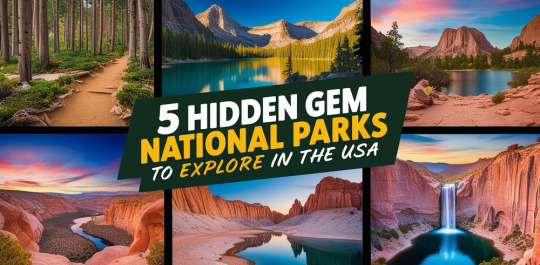
Unveiling America’s Hidden Natural Treasures: 5 Must-Visit National Parks for 2024
Are you looking for unique outdoor adventures off the beaten path?
While America’s most famous national parks like Yosemite and the Grand Canyon are undoubtedly spectacular, there are lesser-known treasures waiting to be discovered.
In this article, we’ll explore five hidden gem national parks that offer breathtaking landscapes, diverse ecosystems, and unforgettable experiences.
These parks may not be as famous as their counterparts, but they’re equally captivating and often less crowded.
Let’s dive into these natural wonders and see why they deserve a spot on your 2024 travel itinerary.
#1 Yellowstone National Park Tour from Jackson Hole

Gallery

Yellowstone National Park: A Geothermal Wonder
Yellowstone National Park, America’s first national park, is a true hidden gem that often gets overshadowed by its more famous cousins.
Located primarily in Wyoming, with parts extending into Montana and Idaho, Yellowstone offers a unique blend of geothermal wonders, diverse wildlife, and stunning landscapes.
Why Yellowstone Should Be on Your 2024 Bucket List
Yellowstone is home to the world’s largest concentration of geysers, including the famous Old Faithful. But there’s so much more to explore:
Geothermal Features: Witness colorful hot springs, bubbling mud pots, and steaming fumaroles.
Wildlife Viewing: Spot bison, elk, wolves, and grizzly bears in their natural habitat.
Grand Canyon of Yellowstone: Marvel at the 308-foot Lower Falls cascading into a colorful canyon.
Yellowstone Lake: Enjoy fishing, boating, or simply relaxing by America’s largest high-elevation lake.
Historic Sites: Visit the Old Faithful Inn and other landmarks that tell the park’s rich history.
To truly appreciate Yellowstone’s wonders, consider booking the “Yellowstone National Park Tour from Jackson Hole” through Viator.
This full-day tour offers an expert guide to help you navigate the park’s vast 2.2 million acres.
You’ll witness Old Faithful’s eruption, admire the vibrant colors of the Fountain Paint Pot, and learn about the park’s unique geology and ecology.
Keep your camera ready for wildlife sightings and breathtaking landscapes that make Yellowstone one of the best national parks in America.
#2 Denali National Park: Alaska’s Crown Jewel
Gallery

3 Hour Naturalist Walking Tour in Denali National Park
Tucked away in the heart of Alaska, Denali National Park is a hidden gem that offers visitors a chance to experience true wilderness.
Home to North America’s tallest peak, Mount Denali (formerly known as Mount McKinley), this park is a paradise for nature lovers and adventure seekers alike.
Discovering the Wonders of Denali
Denali National Park showcases the raw beauty of Alaska’s interior:
Diverse Ecosystems: Explore tundra, taiga forests, and glacial valleys.
Wildlife Viewing: Spot the “Big Five” — moose, caribou, Dall sheep, wolves, and grizzly bears.
Mount Denali: Witness the awe-inspiring 20,310-foot peak (weather permitting).
Backcountry Adventures: Engage in hiking, backpacking, and mountaineering.
Northern Lights: In fall and winter, witness the mesmerizing aurora borealis.
For an intimate introduction to Denali’s natural wonders, book the “3-Hour Naturalist Walking Tour in Denali National Park” through Viator.
This guided walk allows you to immerse yourself in the park’s ecosystem, learning about its unique flora and fauna from an expert naturalist.
You’ll have the opportunity to taste edible berries, feel the spongy tundra beneath your feet, and gain a deeper understanding of this remarkable landscape.
It’s an excellent way to experience one of the most beautiful national parks in the US up close and personal.
#3 Touring and Hiking in Mt. Rainier National Park
Gallery
Mount Rainier National Park: A Cascade Range Gem
Often overlooked in favor of its more famous Mount Rainier National Park is a hidden gem that deserves recognition.
Centered around the iconic 14,410-foot stratovolcano, this park offers a diverse range of landscapes and activities that make it one of the best US national parks.
Exploring the Wonders of Mount Rainier
Mount Rainier National Park is a year-round destination with something for everyone:
Glaciers: Home to the most glaciated peak in the contiguous US.
Wildflower Meadows: In summer, witness stunning displays of colorful wildflowers.
Old-Growth Forests: Walk among ancient trees in the Grove of the Patriarchs.
Waterfalls: Discover numerous cascades, including the 168-foot Narada Falls.
Scenic Drives: Take in breathtaking views along the Sunrise and Paradise Valley roads.
To make the most of your visit, consider booking the “Touring and Hiking in Mt. Rainier National Park” experience through Viator.
This full-day tour from Seattle allows you to explore the park’s highlights, including a hike to a glacier, picturesque stops at Reflection Lake and Christine Falls, and the option to snowshoe in winter.
With an experienced guide, you’ll gain insights into the park’s geology, ecology, and cultural significance, making it an unforgettable adventure in one of America’s best national parks.
#4 Joshua Tree National Park Driving Tour
Gallery

Joshua Tree National Park: A Desert Oasis
Where the Mojave and Colorado deserts meet, you’ll find the otherworldly landscape of Joshua Tree National Park.
This hidden gem in Southern California offers a unique blend of desert ecosystems, distinctive rock formations, and the park’s namesake Joshua trees.
Unveiling the Magic of Joshua Tree
Joshua Tree National Park is a playground for nature lovers, rock climbers, and stargazers:
Unique Flora: Marvel at the iconic Joshua trees and diverse desert plants.
Rock Formations: Explore massive granite monoliths and boulder piles.
Stargazing: Experience some of the darkest night skies in Southern California.
Rock Climbing: Challenge yourself on world-class climbing routes.
Desert Wildlife: Spot bighorn sheep, coyotes, and various bird species.
To fully appreciate the park’s diverse landscapes and hidden treasures, book the “Joshua Tree National Park Driving Tour” through Viator.
This comfortable van tour allows you to cover more ground and see the park’s highlights, including Hidden Valley and Keys View.
With an experienced guide, you’ll learn about the park’s unique geology, diverse plant and animal life, and cultural history.
Whether you’re a first-time visitor or returning to explore more, this tour offers an excellent overview of one of the most beautiful national parks in the US.
#5 Private Tour: Hawaii Volcanoes National Park Eco Tour
Gallery

Private Tour: Hawaii Volcanoes National Park Eco Tour
Our final hidden gem takes us to the Big Island of Hawaii, where Hawaii Volcanoes National Park showcases the raw power of nature.
Home to two of the world’s most active volcanoes, Kilauea and Mauna Loa, this park offers a unique opportunity to witness the Earth’s creative and destructive forces in action.
Discovering the Fiery Wonders of Hawaii Volcanoes
Hawaii Volcanoes National Park is a dynamic landscape that’s constantly changing:
Active Volcanoes: Witness ongoing volcanic activity (when conditions allow).
Lava Tubes: Explore underground tunnels formed by ancient lava flows.
Crater Rim Drive: Take a scenic drive around the Kilauea caldera.
Diverse Ecosystems: Experience rainforests, desert-like terrain, and coastal areas.
Cultural Sites: Learn about Native Hawaiian culture and its connection to the volcanoes.
For an in-depth exploration of this unique park, book the “Private Tour Hawaii Volcanoes National Park Eco Tour” through Viator.
This private, full-day tour focuses on the park’s ecology, geology, and cultural significance.
You’ll have the opportunity to hike along semi-active lava flows, learn about native flora and fauna, and potentially witness a spectacular sunset over the volcanic landscape.
With a knowledgeable guide and the flexibility of a private tour, you’ll gain a deeper appreciation for this extraordinary national park.
Conclusion
These five hidden gem national parks offer unique experiences that rival those of their more famous counterparts.
From the geothermal wonders of Yellowstone to the fiery landscapes of Hawaii Volcanoes, each park showcases a different facet of America’s natural beauty.
By venturing off the beaten path and exploring these lesser-known treasures, you’ll not only avoid crowds but also discover some of the best national parks in America.
Remember to book your tours through Viator for expertly guided experiences that will enhance your understanding and appreciation of these remarkable landscapes.
Whether you’re a nature enthusiast, adventure seeker, or simply looking for a unique vacation destination, these hidden gem national parks are sure to leave you with unforgettable memories.
So pack your bags, grab your camera, and get ready to explore the undiscovered wonders of America’s national parks in 2024!
#National Parks#Best national parks#Best national parks in America#Best US national parks#most beautiful national parks in the us#national parks to explore in the usa#best national parks in usa#top national parks in america#must-visit national parks usa#usa national parks guide#national parks road trip usa#hidden gems in usa national parks#most beautiful national parks usa#famous national parks in the usa#national parks to visit in summer usa#family-friendly national parks usa#usa national parks for hiking#usa national parks travel tips#unique national parks usa#national parks photography spots usa#2024 usa national parks
2 notes
·
View notes
Text
Climate Change Comes to the Tetons. (New York Times)
Excerpt from this New York Times story:
On the wall of my hotel room here at the Jackson Lake Lodge in Moran, Wyo., there is a framed photograph of the spectacular Teton Range taken during the 1950s.
In it, a handful of tourists in short-sleeve shirts admire the jagged, snow-capped peaks. While it is clearly summer in the picture, the mountains are blanketed in snow, with huge glaciers covering much of the granite.
Looking out my window at the same vista this morning, there is not a trace of fresh snowfall to be seen on the peaks forming one of America’s most beautiful mountain ranges. And the glaciers are markedly smaller than they were just 70 years ago.
The signs of a warming planet are everywhere here in Grand Teton National Park. With retreating glaciers, lakes depleted by drought and forests parched by hotter temperatures, climate change is upending one of the great intact ecosystems in North America.
It’s a story playing out around the country. After more than a century of trying to preserve some of the world’s most wondrous natural landscapes, the National Park Service in recent years has shifted its mission away from absolute conservation. It is now making tough decisions about which plants and animals to save, and which they may need to let go. In Washington State, the glaciers on Mount Rainier are melting. In Maine, ecologists are working to save vulnerable trees in Acadia National Park.
“These things are happening so quickly, and they’re being sped up by all the human activity,” said Kirk Ryder, a longtime nature guide in the area who showed me and my family around the park yesterday morning. “Fire activity is increasing, and heat is stressing the wildlife.”
Up on Mount Moran, a hulking slab of granite in the middle of the range, two of the Tetons’ best-known glaciers were exposed to the searing sun. The Falling Ice Glacier and the Skillet Glacier��have both retreated significantly in recent decades. Between 1967 and 2006, at least 25 percent of the park’s glacier cover disappeared, according to a park official.
We passed Jackson Lake, which is dammed and serves as a water source for agriculture in Idaho. Ryder explained how a few years ago, waters in the lake reached historically low levels. A lighter than usual snowpack the year before, followed by a spring and a summer devoid of the usual rains, meant that farmers and ranchers sucked the lake dry, leaving boats stranded in mud in Colter Bay, a popular tourist destination.
Over the past 110 years or so, the average daytime high temperatures in the Tetons have not changed significantly. But the nighttime low temperatures have increased between 3 and 4 degrees Fahrenheit.
As a result of this nighttime warming trend, the National Park Service expects the Grand Teton to see seven to 14 fewer weeks of below-freezing temperatures by late this century.
“There’s an overall warming trend that’s substantial and that is projected to continue,” said Andrew Hansen, an ecology professor at Montana State University who has studied the effects of climate change on the greater Yellowstone region, which includes the Tetons. “There are big implications for snow pack. There’s less precipitation falling as snow versus rain, and more rapid melting, and both of those lead to increased aridity. There’s more drought, there’s more drought-stressed forest and vegetation, more drying of fuels and hence increased fire risk.”
4 notes
·
View notes
Text
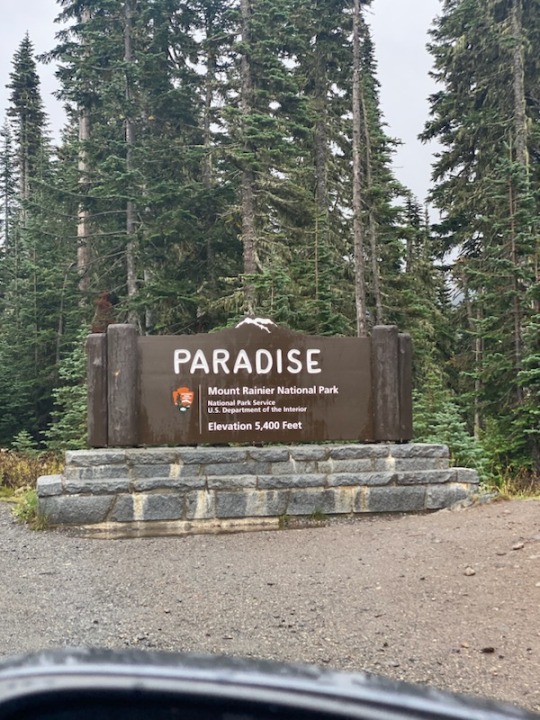



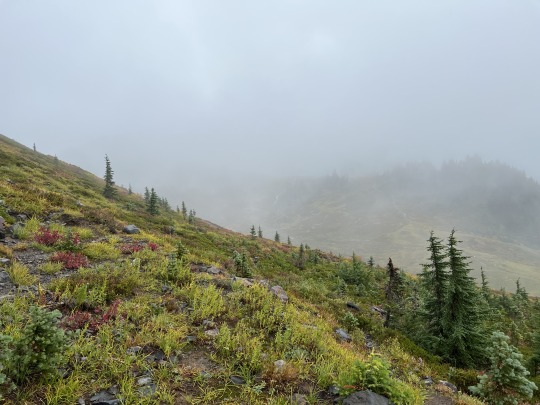




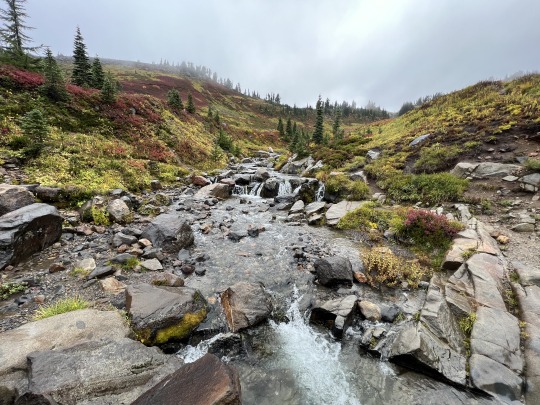




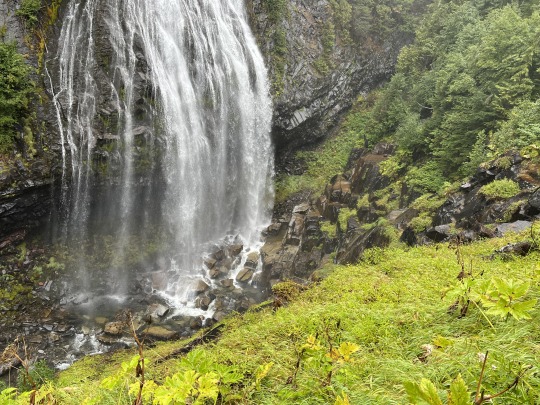
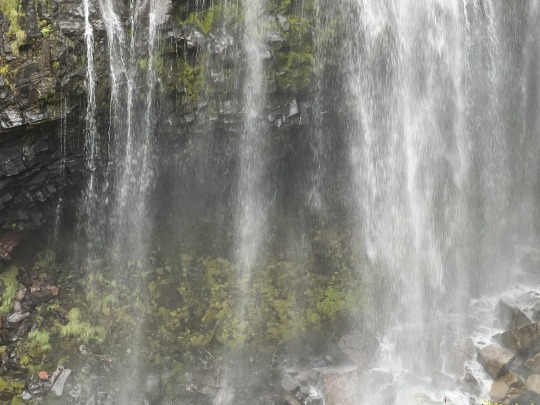





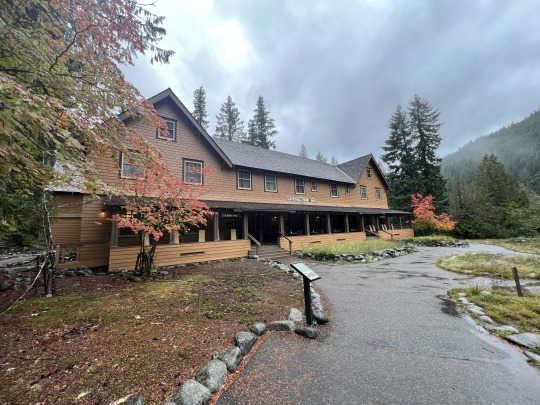




Mount Rainier, Park 3!
The hike back down our trail was foggy and as beautiful as the way up! We saw several deer and lots of grouse who took up plenty of trail for the their small size! We also hiked to both Myrtle and Narada Falls to take in more of the glacier river that also make up the park. Fun fact- the milky blue gray color comes from "glacier flour", the term for the finer than sand sediment that travels along when the ice melts.
On our way down Paradise Valley Road we stopped at several scenic overlooks. One in particular showed Nisqually Glacier and where it had reached historically. As early as the 1890’s the glacier was noted to be receding and between 1896-2015 it lost over 20 square miles. This glacier is one of 29 in Mt Rainier and all have receded due to a warming climate.
As we weaved our way down mountain roads we reached the historic Longmire area of the park. When Mount Rainier was established as a national park in 1899 the town became its headquarters. The museum was built in 1916 as a main office and today houses exhibits on the geology and wildlife of the park. What is now the Longmire wilderness info building was another main admin building and is from 1930. We also checked out the National Park Inn, general store and transportation station exhibit. Finally we rode over Nisqually Suspension Bridge and wrapped a wonderful, if rainy, day!
2 notes
·
View notes
Text
Kerry Park

Kerry Park in Seattle, WA: A Must-Visit Destination for Stunning City Views
Seattle, Washington, is a city known for its breathtaking landscapes, iconic landmarks, and vibrant culture. Among its many attractions, Kerry Park stands out as a must-visit destination, offering some of the most stunning panoramic views of the Seattle skyline. Whether you're a local resident or a tourist exploring the Emerald City, Kerry Park is the perfect spot to capture postcard-worthy photos and enjoy a serene escape from the bustling city below.
A Picture-Perfect View of Seattle
Located on Queen Anne Hill, Kerry Park is renowned for its unparalleled view of downtown Seattle, complete with the Space Needle, Mount Rainier in the background, and Elliott Bay glistening in the distance. The park's vantage point provides a classic Seattle photo opportunity that has been featured in countless travel guides, movies, and television shows. Visitors often arrive during sunrise and sunset to witness the city bathed in golden hues, creating a magical and unforgettable experience.
History of Kerry Park
Kerry Park was gifted to the city of Seattle in 1927 by Albert S. Kerry and his wife, Catherine Kerry. The couple donated the land with the specific intention of preserving the breathtaking view for future generations. Over the years, the park has become a beloved landmark, attracting photographers, couples, families, and travelers seeking to capture the essence of Seattle in a single frame.
What to See and Do at Kerry Park
While Kerry Park is relatively small—covering just 1.26 acres—it offers a range of activities and sights that make it a worthwhile stop. Here are some highlights to explore:
Iconic Viewpoint: The park's main attraction is its panoramic view of the Seattle skyline, including the Space Needle, downtown skyscrapers, Mount Rainier, and Elliott Bay. On clear days, you may even spot the Olympic Mountains in the distance.
Photography Opportunities: Kerry Park is a favorite spot for photographers of all skill levels. Whether you're capturing a stunning sunset, a nighttime cityscape with twinkling lights, or a foggy morning that adds a touch of mystery, every shot from Kerry Park is Instagram-worthy.
Sculpture: Changing Form: Art enthusiasts will appreciate the abstract steel sculpture titled Changing Form by artist Doris Totten Chase. Installed in 1971, the sculpture adds an artistic touch to the park and frames the cityscape beautifully, making it a popular subject for creative photography.
Peaceful Atmosphere: Despite its popularity, Kerry Park maintains a peaceful and tranquil atmosphere, making it an ideal place to relax, unwind, and take in the beauty of Seattle. Many visitors enjoy sitting on the park benches, savoring a coffee, and soaking up the scenery.
Tips for Visiting Kerry Park
To make the most of your visit to Kerry Park, consider the following tips:
Best Time to Visit: Sunrise and sunset are the most popular times to visit, as the soft lighting creates a stunning backdrop for photos. If you prefer a quieter experience, consider visiting on weekdays or during early morning hours.
Parking: Parking near Kerry Park can be limited, especially during peak times. Be prepared to park on nearby residential streets and walk a short distance to the park.
Weather Considerations: Seattle's weather can be unpredictable, so check the forecast before your visit. Clear days offer the best views of Mount Rainier and the surrounding mountains.
Accessibility: The park is easily accessible, with paved pathways and benches for those who wish to sit and enjoy the view.
Nearby Attractions and Activities
Kerry Park's location on Queen Anne Hill places it within close proximity to several other attractions and activities worth exploring. Consider adding the following to your itinerary:
Queen Anne Neighborhood: Stroll through the charming Queen Anne neighborhood, known for its historic homes, boutique shops, and cozy cafes. It's a great place to explore before or after your visit to Kerry Park.
Seattle Center: Just a short drive away, Seattle Center is home to iconic attractions like the Space Needle, Chihuly Garden and Glass, and the Museum of Pop Culture (MoPOP).
Elliott Bay: Head down to the waterfront to explore Elliott Bay, where you can enjoy scenic walks, waterfront dining, and boat tours that offer unique perspectives of the city.
Discovery Park: For nature enthusiasts, Discovery Park offers hiking trails, beaches, and breathtaking views of Puget Sound, making it a perfect complement to your Kerry Park visit.
Why Kerry Park Should Be on Your Seattle Bucket List
Kerry Park's reputation as one of Seattle's most iconic viewpoints is well-deserved. Its stunning cityscape, peaceful ambiance, and rich history make it a must-visit destination for anyone exploring the Emerald City. Whether you're capturing the perfect photograph, enjoying a romantic sunset, or simply soaking in the beauty of Seattle, Kerry Park offers an unforgettable experience that will leave a lasting impression.
Don't miss the chance to experience this beloved Seattle gem—add Kerry Park to your travel itinerary and discover why it's a favorite spot for locals and visitors alike.
Show your support for one of our partner businesses.
211 W Highland Dr, Seattle, WA 98119, United States
Visit this next site.
0 notes
Note
I TOO LOVE THE ELSA SPEAK NOW DRESS, it’s so prettyyyy. Did you know that Elsa is secretly an ambassador for the North Pole? She’s one of my minions (not like an elf. More like the role penguins and polar bears and gingerbread men play in spreading Christmas spirit on behalf of my entity.).
As I’m preparing for my global travel next week, I’d like to hear more about your hometown/state. Most of my prep for the PNW is around planning how to drop coal off at the Cullen’s house without getting caught by magic powered vampires…
I know you like hiking and camping. Are there any other fun local activities? Are there any favorite restaurants or cute shops or scenic town squares that you’ve visited that I should print on my Christmas cards? Do you like the weather and the forests? Is there any other part of the world you’d like to try living in?
Love, 🎅
Hahaha I live on the West side of the state, much closer to Seattle than Forks (which I hate to admit as a Twilight fan, I have never been to Forks).
My town is kind of in the middle of other towns and isn't one of those cutesy towns, it is closer to the town of Snohomish which is definitely a "cuter" area haha. Historic Downtown Snohomish has some awesome little shops including an amazing pie company and my fave candle place Malicious Women Candle Co (I recommend checking them and their story out).
I definitely wish I lived closer to the mountains but my cousins are 45 minutes close to Mount Rainier where we camp every year. They're as close to it as I am to Seattle (on a good traffic day lol). I'm not a super city girl or a super country girl but I'm closer to a mountain girl? Haha.
I would love to live in England or Australia.
0 notes
Text
Feel the Adrenaline Rush in the Best Hiking Spots in Seattle, Washington

A nature lover's heaven, Seattle in Washington offers a spectacular canvas between Puget Sound and the Cascade Mountains. There are wonderful trails, ranging from strolls to hikes up mountainous inclines, all offering stunning views. Whether a seasoned hiker or an easy-going enthusiast looking for adventure, Seattle's hiking areas are offering something for everyone. Here are some top trails to explore in and around the Emerald City.
Discovery Park
For a less intense hike that is still not to be missed within downtown Seattle limits, try Discovery Park. This is the city's largest greenspace, offering hiking trails of both easy and moderate difficulty. You will find wildlife and breathtakingly-beautiful views of the Olympic Mountains as you walk through forests, along the coastline of the Puget Sound, and past an historic lighthouse. Discovery Park is best for a weekend or an afternoon getaway from the city.
Mount Si
For the more adventurous who are willing to push their limits, Mount Si is the appropriate challenge. This 40 minutes east of Seattle 8-mile round-trip hike climbs 3,150 feet, making it quite tough but very rewarding all the way to the summit. The summit provides a magnificent view over the Snoqualmie Valley, the Cascade Mountains, and, on very clear days, Mount Rainier. It's quite possibly one of the best viewing situations in the entire region after attaining the summit of this hike.
Rattlesnake Ledge
One of the closest and most popular hikes from Seattle, the grand views of the Snoqualmie River Valley, as well as rewarding surrounding peaks of Rattlesnake Ledge await hikers on this moderate, 4-mile round-trip trail. The well-maintained trail takes you through lush forests to an upward climb toward the summit. Once atop the ledge, view the breathtaking vista perfect for a photo opportunity or just basking in the vast natural beauty of the Pacific Northwest.
Twin Falls
Just outside Seattle in the Snoqualmie region, Twin Falls is a family-friendly hike through a beautiful forest with wonderful views of waterfalls. This 3.6-mile round-trip trail is relatively easy to moderate and nice for everyone to handle. Along the trail, the rushing sounds of water and vibrant greenery of the surrounding trees create pleasant hiker stops.
Plan Your Seattle Adventure with OceanBeachTravel.com
The beauty of Seattle’s hiking is from varied trails with lush forests and dramatic mountain vistas. World-famous sights such as Mount Rainier, Snoqualmie Falls, and the Cascades make the environment a paradise for an outdoorsman. Enjoy peaceful lakes, wildlife, and unbeatable views.
Ready to explore Seattle's hiking trails? OceanBeachTravel.com can guide you through the process of making your next outdoor adventure. If it's a great hiking itinerary or expert travel tips, Ocean Beach Travel has everything you need to make your trip unforgettable.
For personal travel suggestions, please contact Bradley Schnickel of OceanBeachTravel.com. Years of experience combined with a love for the outdoors make Bradley the perfect person to help you tailor the ideal hiking experience to your interests and fitness level. Ready, set, hike! Your adventure awaits!
0 notes
Text

NPS Photo of Mount Rainier with a portion of Mowich Lake Road viewed from Tolmie Peak in 1961 (Eunice Lake is in the foreground with Mowich Lake in the distance).
Mowich Lake Road, like other park roads, was initially planned as part of an “around-the-mountain” road system. Mowich Lake Road starts in the northwest corner of the park and was intended to connect to Westside Road, which starts from the southwest corner. The two roads were never completed due to budget constraints and the rugged topography of the mountain. Constructed from 1929-1934, Mowich Lake Road remains a six-mile long spur road (reached via SR165) and is a discontiguous portion of the Mount Rainier National Historic District. Original features along the road include one stone retaining wall and 39 rustic culverts with mortared stone headwalls.

Mount Rainier National Park Archives Photo of the Mowich Entrance Dedication in 1933.
Mowich Lake Road was dedicated in 1933 at the Mowich Lake Entrance (now at Paul Peak Trailhead). At the dedication, a log memorial was constructed in honor of Dr. William Fraser Tolmie who visited Mount Rainier a hundred years earlier in 1833 on a botanizing trip. The log memorial was intended to be incorporated into an entrance arch. The arch was never completed and the memorial no longer exists. Footage of the Mowich Lake Road dedication event can be viewed at: https://go.nps.gov/MMem-MowichDedication
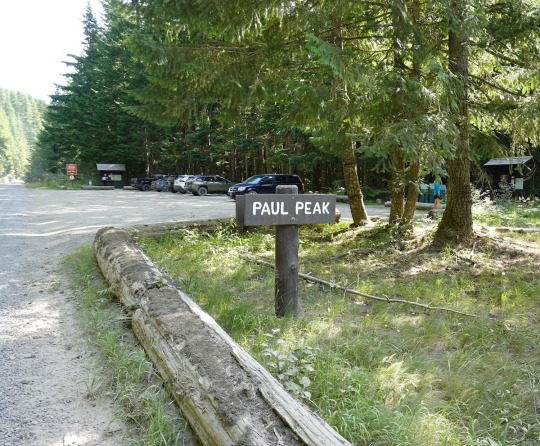
NPS Photo of the current Mowich Lake Road Entrance at Paul Peak Trailhead, 8/17/23.
While dedicated in 1933, delays due to construction and then WWII limited access and Mowich Lake Road did not open to vehicle traffic until July 1955. Have you traveled the historic Mowich Lake Road?
#Historic Mount Rainier#mount rainier national park#Mowich Lake#Mowich Lake Road#Paul Peak#Paul Peak Trailhead#historic road#national historic landmark district#history
62 notes
·
View notes
Text
Best Cities to Visit in the USA 2024
Best Cities to Visit in the USA 2024
The United States is an expansive country filled with unique cities that offer an array of experiences. From the cultural hotbeds to relaxing coastal retreats, there’s a perfect destination for every traveler. Here are the best cities to visit in the USA in 2024, each promising unforgettable memories and vibrant experiences.
1. New York City, New York
A perennial favorite, New York City remains at the top of must-visit lists for 2024. Known as “The City That Never Sleeps,” New York offers iconic attractions like Times Square, Central Park, and the Statue of Liberty. Art enthusiasts will enjoy the ever-evolving exhibitions at the Met and MoMA, while food lovers can sample everything from high-end dining to street eats. New developments, such as the upgraded areas of Midtown, continue to enhance its allure.
2. Austin, Texas
Austin has solidified its reputation as a cultural and tech hub. The city’s famed music scene—encompassing rock, blues, and country—draws crowds year-round, particularly during the renowned SXSW Festival. Visitors should also explore Austin’s culinary scene, known for mouthwatering BBQ and creative food trucks. Outdoor enthusiasts will love paddleboarding on Lady Bird Lake, while those seeking a vibrant nightlife won’t be disappointed by the city’s bar scene.
3. San Diego, California
If sunshine and beach vibes top your list, San Diego is an unbeatable choice. This city is famous for its perfect weather, stunning beaches, and family-friendly attractions like Balboa Park and the San Diego Zoo. The city’s Gaslamp Quarter is the go-to spot for dining and nightlife, while coastal areas like La Jolla offer picturesque views and upscale dining. In 2024, San Diego is focusing on sustainability, with eco-friendly tours and parks becoming more prominent.
4. Charleston, South Carolina
For a dose of Southern charm and history, Charleston is unmatched. The city’s cobblestone streets, antebellum architecture, and coastal beauty create a captivating atmosphere. Known for its impressive Lowcountry cuisine, Charleston is a delight for foodies. Visitors can tour historic plantations, enjoy boat tours, or simply take in the sights along the waterfront. The city’s slower pace and historical depth make it a perfect destination for a relaxed getaway.
5. Seattle, Washington
Seattle, with its blend of natural beauty and urban excitement, is an appealing city for 2024. From the bustling Pike Place Market to the iconic Space Needle, there’s much to explore. The city is surrounded by breathtaking landscapes, including the Puget Sound and Mount Rainier, which are perfect for hiking or boating. Seattle’s art scene is set to shine in 2024, with new exhibitions and an expanded waterfront attracting visitors from near and far.
6. Miami, Florida
Miami’s blend of sun, sea, and culture makes it a perennial hotspot. The city’s Art Deco architecture and vibrant neighborhoods like Little Havana offer unique cultural experiences. Visitors can lounge on South Beach by day and experience the city’s famed nightlife by night. Art Basel Miami Beach, held annually, is a must for art lovers. Miami’s evolving tech scene in 2024 also adds an intriguing new layer for travelers interested in innovation.
7. Chicago, Illinois
Chicago, with its rich architecture and lively arts scene, is a standout city to visit in 2024. The Windy City offers attractions like Millennium Park, home to the famous Cloud Gate sculpture, and the Art Institute of Chicago. During summer, events such as Lollapalooza and the Chicago Jazz Festival are perfect for music enthusiasts. New developments along the waterfront make Chicago even more appealing for both tourists and locals.
8. Honolulu, Hawaii
Honolulu provides more than just stunning beaches—it’s a cultural haven with a blend of Polynesian, Asian, and American influences. Visitors can explore historical sites such as Pearl Harbor, hike Diamond Head for panoramic views, or simply relax on the famed Waikiki Beach. In 2024, Honolulu will spotlight traditional Hawaiian music, dance performances, and festivals, creating an immersive experience for visitors.
Conclusion
From coast to coast, the USA boasts cities that cater to every interest. Whether you’re seeking the nonstop energy of a big city or the laid-back charm of a historic town, 2024 promises unforgettable travel experiences across America. Make your plans and explore what each city has to offer!

0 notes
Text
A Trip Outside of the City for a Day
The city is amazing, but sometimes you just want a quick escape from city life. Luckily, the Seattle area has tons of day-trip options, from mountains to islands to historic towns. Here are some of the best day trips that’ll let you experience the Pacific Northwest in all its glory.
1. Snoqualmie Falls 🌊
Just 45 minutes from Seattle, Snoqualmie Falls is a stunning 268-foot waterfall that’s worth every second of the drive. There’s an easy viewing platform if you just want a quick look, but you can also take a short hike down to the river for an up-close experience. Plus, there’s Salish Lodge right at the top of the falls where you can grab coffee or even brunch with a view. It’s a great spot to breathe in some fresh air and enjoy Washington’s natural beauty.
2. Bainbridge Island 🛥️
Hop on a ferry from downtown Seattle, and in just 35 minutes, you’ll be on Bainbridge Island. Once you’re there, explore charming shops, art galleries, and local eateries in the downtown area. The island is also great for biking if you’re up for an active day. Check out the Bloedel Reserve, a serene 150-acre garden that feels like stepping into a different world. The ferry ride itself is also a highlight, giving you amazing views of the Seattle skyline and Puget Sound. I love the ride back at night - the view of the city is unbelievable.
3. Leavenworth 🏔️
If you’re in the mood for a change of scenery, head two hours east to Leavenworth, a Bavarian-style village nestled in the Cascades. This place looks like something straight out of Europe, with its alpine buildings, beer gardens, and endless pretzels. Each season brings something special—snowy magic in the winter, colorful festivals in fall, and river tubing in summer. It’s the perfect day trip for trying German food, shopping for unique souvenirs, and taking in mountain views.
4. Mount Rainier National Park 🏞️
This one’s a bit of a drive (around two hours), but if you’re up for a nature adventure, Mount Rainier National Park is unbeatable. The park has endless hiking trails, wildflower meadows, and viewpoints of the towering Mount Rainier. In the summer, Paradise Valley is covered in wildflowers, and in the winter, the snow transforms the park into a winter wonderland. It’s a must-visit for any nature lover and a great way to experience Washington’s most iconic peak up close.
5. Whidbey Island 🍃
Another island adventure awaits with Whidbey Island, which is accessible by a quick drive and ferry ride or via the scenic Deception Pass Bridge. Known for its small-town charm and rugged beaches, Whidbey is perfect for a laid-back day trip. Check out Ebey’s Landing for a coastal hike with amazing views, or wander through Coupeville, one of the oldest towns in Washington, with cozy cafes and waterfront views. It’s the kind of place that lets you slow down and soak in the scenery.
(Blog #6)


0 notes
Text
Romantic Getaways in Washington State

Washington State is a treasure trove of breathtaking landscapes, charming towns, and intimate hideaways, making it a perfect destination for romantic getaways. Whether you're looking for a cozy cabin in the mountains, a serene beachfront retreat, or a luxurious hotel in the city, Washington offers diverse options that cater to every couple's desires. In this blog post, we'll explore some of the best romantic getaways in Washington State, highlighting unique experiences and settings that will make your trip memorable.
1. Leavenworth: A Bavarian Paradise
Nestled in the Cascade Mountains, Leavenworth is a picturesque Bavarian-themed village that exudes charm and romance. This quaint town is perfect for couples looking to escape into a whimsical setting.
Highlights:
Scenic Strolls: Wander through the charming streets lined with shops, cafes, and art galleries. The stunning mountain backdrop adds to the romantic ambiance.
Outdoor Adventures: In winter, enjoy skiing or snowshoeing, while summer offers hiking and river rafting. Spend your evenings by the fire, sipping local wine.
2. San Juan Islands: A Coastal Escape
The San Juan Islands, accessible by ferry, offer a serene getaway surrounded by water and nature. With stunning views and abundant wildlife, this destination is perfect for couples seeking tranquility.
Highlights:
Whale Watching: Embark on a whale-watching tour to see orcas and other marine life in their natural habitat.
Charming Accommodations: Choose from cozy bed-and-breakfasts or luxury resorts like The Resort at Deer Harbor, where you can enjoy spa treatments and gourmet dining.
3. Whidbey Island: Romantic Seclusion
Whidbey Island is known for its stunning landscapes and peaceful atmosphere, making it an ideal spot for a romantic retreat. This island offers a blend of adventure and relaxation.
Highlights:
Beachfront Getaways: Stay in charming beachfront cottages or upscale hotels like the Inn at Langley, which boasts breathtaking views and gourmet breakfast.
Explore the Arts: Visit local galleries and artisan shops, or enjoy a romantic dinner at one of the island's acclaimed restaurants.
4. Seattle: Urban Romance
For couples who enjoy the vibrancy of city life, Seattle offers a perfect blend of urban excitement and romantic spots. With stunning waterfront views and a lively arts scene, there’s something for everyone.
Highlights:
Iconic Landmarks: Visit the Space Needle for panoramic views of the city and Mount Rainier. Explore Pike Place Market for fresh seafood and local crafts.
Romantic Dining: Enjoy a dinner cruise on Elliott Bay or dine at a rooftop restaurant like Canlis, which offers exquisite cuisine and stunning views.
5. Mount Rainier National Park: Nature's Beauty
For nature-loving couples, Mount Rainier National Park is a breathtaking destination. With its majestic mountain views, alpine meadows, and serene lakes, it’s a perfect escape.
Highlights:
Scenic Hikes: Explore miles of hiking trails that lead to stunning vistas. Consider the Skyline Trail for unforgettable views of the mountain and wildflower-filled meadows.
Cozy Lodging: Stay at the historic Paradise Inn, where you can enjoy rustic charm and easy access to the park’s natural beauty.
6. Columbia River Gorge: Wine and Waterfalls
The Columbia River Gorge is a stunning destination known for its breathtaking waterfalls and world-class wineries. This area offers the perfect blend of outdoor adventure and relaxation.
Highlights:
Wine Tasting: Visit local wineries for tastings and vineyard tours. Enjoy a romantic picnic while soaking in the scenic views of the gorge.
Waterfall Adventures: Hike to iconic waterfalls like Multnomah Falls and Bridal Veil Falls, both of which offer breathtaking backdrops for romantic photos.
7. Olympic National Park: Diverse Landscapes
Olympic National Park is a diverse wonderland, offering everything from rugged coastline to lush rainforests and majestic mountains. It’s an ideal location for couples who love exploring nature together.
Highlights:
Hoh Rain Forest: Walk hand in hand through the enchanting Hoh Rain Forest, surrounded by towering trees and vibrant moss.
Coastal Escapes: Relax on the beautiful beaches of the Pacific Coast, such as Rialto Beach, where you can enjoy sunsets and beachcombing.
8. Spokane: A Hidden Gem
Spokane, located in Eastern Washington, offers a unique blend of urban charm and outdoor adventure. This city is often overlooked but has much to offer for romantic getaways.
Highlights:
Riverfront Park: Take a romantic stroll through Riverfront Park, featuring beautiful gardens, a river, and the iconic Spokane Falls.
Spa Experiences: Treat yourselves to a couple’s spa day at one of Spokane’s luxurious spas, followed by dinner at a fine restaurant like Clover.
Accommodations: For the best options, check out b0arding.com for hotels and vacation rentals while on your romantic getaway.
Conclusion
Washington State is filled with romantic getaway options that cater to every couple’s taste. From the whimsical charm of Leavenworth to the serene beauty of the San Juan Islands, each destination offers unique experiences and unforgettable memories. Whether you seek adventure, relaxation, or a combination of both, Washington's diverse landscapes and vibrant cities provide the perfect backdrop for a romantic escape.
As you plan your next getaway, consider these romantic destinations in Washington State. Embrace the beauty of nature, indulge in local cuisine, and create lasting memories with your loved one. Happy travels!
#travel tips#travel#hotels and resorts#romantic getaway#travel experiences#travel season#travel budget#traveling
0 notes
Text
The Great American Road Trip: Coast-to-Coast Adventures
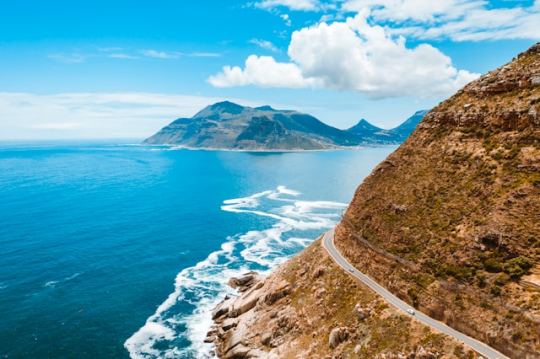
The allure of the open road and the diverse landscapes of the United States make a coast-to-coast road trip the ultimate adventure for travelers. For Bangladeshi explorers, this journey offers a unique opportunity to experience the vastness and variety of America, from bustling cities and quaint towns to stunning national parks and serene coastlines.
Starting Point: New York City, New York
Begin your epic road trip in New York City, the bustling metropolis known for its iconic landmarks and vibrant culture. Stroll through Central Park, visit the Statue of Liberty, and immerse yourself in the art at the Metropolitan Museum of Art. Don’t miss Times Square’s dazzling lights and the diverse culinary scene that spans from street food to Michelin-starred restaurants.
Heading South: Washington, D.C., and the Blue Ridge Parkway
From New York City, drive south to Washington, D.C., the nation's capital. Explore the National Mall, home to monuments and museums such as the Lincoln Memorial and the Smithsonian Institution. After soaking in the history and culture, head towards the Blue Ridge Parkway, a scenic route that winds through the Appalachian Mountains. Enjoy the breathtaking views, hiking trails, and charming small towns along the way.
The Deep South: Nashville, Memphis, and New Orleans
Continue your journey into the heart of the Deep South. In Nashville, Tennessee, experience the birthplace of country music with visits to the Country Music Hall of Fame and live performances at the Grand Ole Opry. Next, head to Memphis, home of the blues and the legendary Graceland, Elvis Presley’s former residence.
Travel further south to New Orleans, Louisiana, a city known for its rich history, vibrant music scene, and unique cuisine. Explore the French Quarter, enjoy jazz music on Bourbon Street, and savor Creole and Cajun dishes like gumbo and beignets.
The Heartland: Texas and the Southwest
Drive west through Texas, where you can experience the distinct culture and landscapes of the Lone Star State. Visit Austin, known for its live music scene and eclectic vibe, and San Antonio, home to the historic Alamo and the beautiful River Walk.
Continue into the Southwest, stopping at Carlsbad Caverns National Park in New Mexico to explore its stunning underground formations. In Arizona, the awe-inspiring Grand Canyon awaits, offering breathtaking vistas and numerous hiking opportunities.
The West Coast: California’s Pacific Highway
Head towards the Pacific Coast and drive along California’s iconic Highway 1, also known as the Pacific Coast Highway. Start in San Diego, with its beautiful beaches and vibrant nightlife. Make your way north to Los Angeles, where you can visit Hollywood, stroll along Venice Beach, and explore the Getty Center.
Further up the coast, experience the charm of Santa Barbara and the dramatic coastline of Big Sur. Finally, reach San Francisco, where you can walk across the Golden Gate Bridge, visit Alcatraz Island, and explore the diverse neighborhoods like Chinatown and Haight-Ashbury.
The Final Leg: The Pacific Northwest
Your coast-to-coast adventure concludes in the Pacific Northwest. Drive north to Portland, Oregon, known for its lush parks, coffee culture, and craft breweries. End your journey in Seattle, Washington, where you can visit the iconic Space Needle, Pike Place Market, and the beautiful surrounding areas such as Mount Rainier and the Puget Sound.
Conclusion
The Great American Road Trip is more than just a journey from coast to coast; it’s an exploration of the diverse cultural, historical, and natural landscapes that make the United States unique. For Bangladeshi travelers, this adventure offers an unforgettable experience of discovery and excitement.
Plan Your Great American Road Trip with Roomchai Limited Roomchai Limited specializes in creating customized travel packages for Bangladeshi travelers. From planning your route to booking accommodations and providing expert travel tips, Roomchai Limited ensures your coast-to-coast adventure is seamless and memorable. Embark on the ultimate American road trip with Roomchai Limited and create memories that will last a lifetime.
0 notes
Text





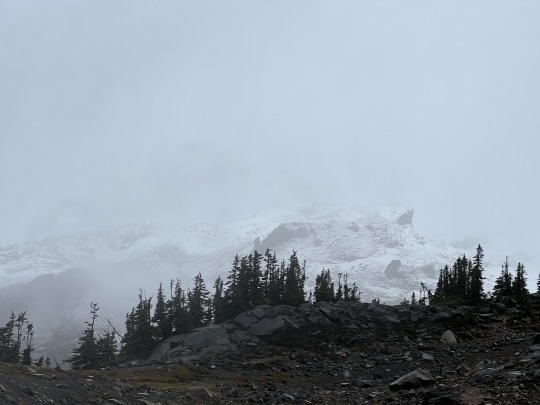



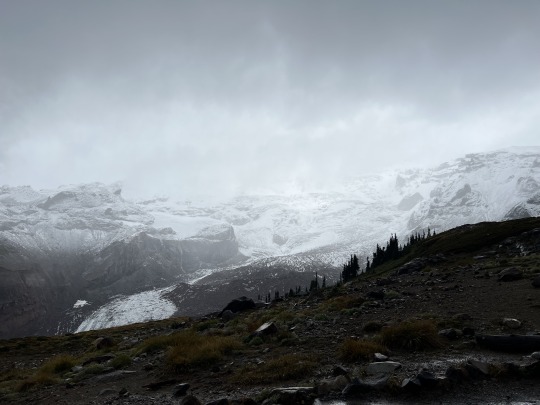

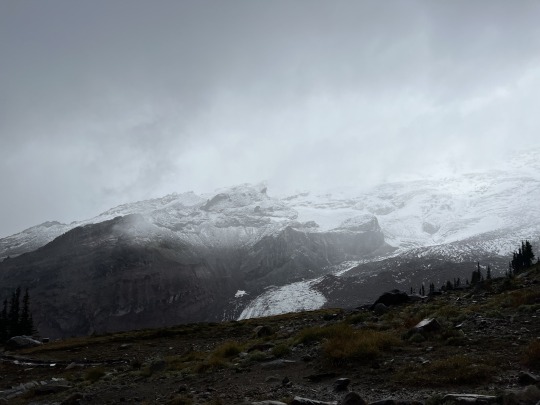




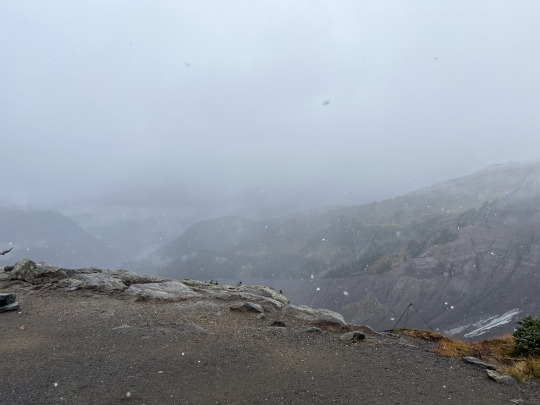
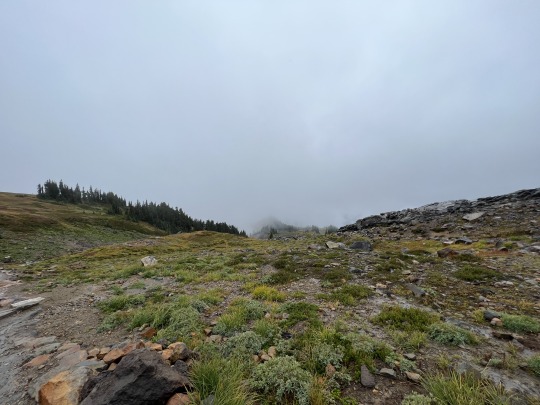
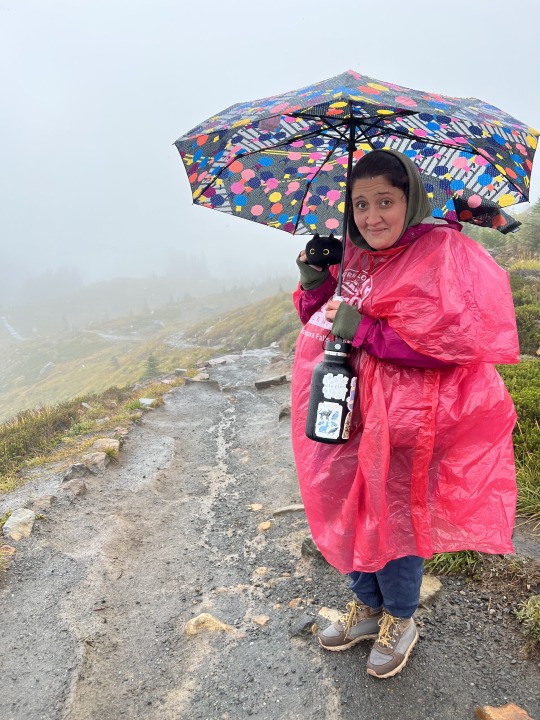
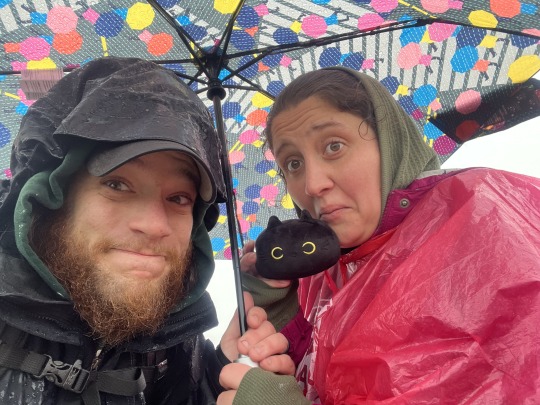

Mount Rainier Pt. 2
Wow.... Wowie WOW WOW...
Mount Rainier is beautiful!!! Absolutely stunning. Gorgeous! I could go on and on describing the mountain but I will say that everyone should try to see this mountain (or any mountain). We fought our way through the snow and I am so glad that we did. While the peaks of Mount Rainier never fully cleared we got to see most of the summit and seeing it in a clear day just means we have a great reason to come back! We spent as much time enjoying the view as we could since there was another storm right behind the clear weather.
We brought up our mini Mia because she deserved those beautiful views too (and we miss our kitten so much!!!!).
Making our way down for 6340' was much much easier than the climb up but it was so worth. Thankful again for the warmth and water of the Ranger Station at the top of Paradise. We headed back to down the mountain to check out the historical Longmire region!
-Nick (edits by Jess)
2 notes
·
View notes
Text
The Ultimate Guide to Outdoor Adventure at Mount Rainier National Park Washington

by Paige Guscott Discover the thrill of outdoor adventure at Mount Rainier National Park, Washington with our comprehensive guide. From hiking trails to breathtaking views, plan your ultimate escapade today! Join us now and embark on an unforgettable journey..... Introduction Welcome to Mount Rainier National Park Washington, a towering testament to nature's awe-inspiring beauty. Before we set foot on the trails or gaze up at the glacier-capped peaks, let's dive into the rich history of one of America's first national parks. Mount Rainier isn't merely a mountain; it's a place where past and present converge, inviting us to explore not just its landscapes but also its legacy. IntroductionHistory of Mount Rainier National Park Washington Establishment of Mount Rainier as a National Park A Peak Like No Other Elevation That Commands Respect Volcanic Power Sleeping Beneath A Refuge for Biodiversity Human Footprints Across Time Flora: A Tapestry of Plants Fauna: Creatures Great and Small Adrenaline-Pumping Activities Hiking Trails for All Levels Safety Measures and GuidelinesEncounters with Wildlife Respect the Environment The Rich History of Mount Rainier National Park Washington Indigenous Communities and Preservation Educational Opportunities for Visitors Inside the Park: Historic Inns and Wilderness Camps Near the Park: Cabins, Lodges, and Resorts Camping and RV Sites Backcountry Camping for the Adventurous Permits, Camping Options, and Visitor Centers Best Times to Visit and Weather Conditions Hidden Gems within the Park Learning More About Mount Rainier National Park Contributing to Mount Rainier National Park History of Mount Rainier National Park Washington Photo by WikiImages on Pixabay The story of Mount Rainier stretches back thousands of years, with its first human interactions traced to the Indigenous tribes who viewed the mountain as a spiritual icon. Known as "Tahoma" or "Tacoma" by the Indigenous peoples, this colossal stratovolcano has been a prominent landmark throughout the ages. European-American exploration began in the late 18th century, with the mountain being named after Rear Admiral Peter Rainier by Captain George Vancouver in 1792. Establishment of Mount Rainier as a National Park On March 2, 1899, President William McKinley signed legislation establishing Mount Rainier National Park Washington as America's fifth national park, putting it under the stewardship of the National Park Service. This pivotal moment marked the beginning of a concerted effort to preserve the mountain's ecosystems and cultural heritage. It was an acknowledgment of the park's extraordinary value, not only as a sanctuary for wildlife and flora but also as a source of inspiration and recreation for all those who visit. As we embark on our journey through Mount Rainier National Park, these foundational stories lay the groundwork for all that we will experience. From the first bloom of spring wildflowers to the silent watch of ancient trees, every element here tells a part of Mount Rainier's enduring tale. So, let's lace up our boots, fill our lungs with crisp mountain air, and prepare to be captivated by the park's many wonders, both visible and those tucked away in the folds of history. 5 Facts About Mount Rainier Carving a striking silhouette against the Washington skyline, Mount Rainier holds tales and truths as fascinating as its glaciers are deep. Following the rich history of this natural wonder, here are five intriguing facts that stand out about Mt Rainier: A Peak Like No Other Mount Rainier isn't just another mountain—it's the most glaciated peak in the contiguous United States, boasting 26 major glaciers that cover 35 square miles of its surface. These icy giants serve as the source for six major rivers, which in turn serve as foundational elements to the many different habitats located on and around the mountain. The Emmons Glacier, for example, is the largest single glacier by area, excluding ice fields, in the continental United States, and the Carbon Glacier lays claim to being the thickest and longest. This glacial grandeur not only shapes the side of the mountain but also supports a diverse ecosystem and supplies water to nearby communities. Elevation That Commands Respect Mount Rainier's summit stands proudly at an elevation of 14,411 feet, making it the highest mountain in Washington and the Cascade Range. This elevation doesn't just make for breathtaking views but also means that the weather can be unpredictable and severe. Even in summer, these heights can harbor cold temperatures and snowfall. Climbing to the summit is an adventure that requires preparation, respect for the mountain's power, and acknowledgement of its potential dangers. Volcanic Power Sleeping Beneath Beneath the serene snow-capped peak lies a giant slumbering volcano. Mount Rainier is part of the Pacific Ring of Fire and is considered one of the most dangerous volcanoes in the world, due to its large amount of glacial ice and proximity to metropolitan areas. If awakened, the lahars—volcanic mudflows—could pose significant risks..... Read More... Read the full article
0 notes